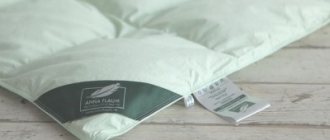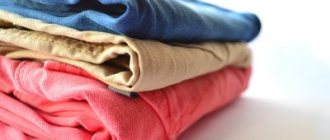Flowers, decorations for important celebrations or small decorative elements - all of this must be made from materials of the highest quality, additionally meeting the criteria of elegance and style. Organza is a fabric that allows you to achieve the perfect, stylish result in a simple way, even without special skills. It can be both natural and artificial. There are many options for using it. This is one of the materials from which you can create almost anything related to the word “decoration”. In addition, we are talking about a very elastic fabric, which makes it easier to work with. The most common products are tulle and organza curtains. Shawls and scarves made from this material are no less famous. Since it is becoming more and more popular, you need to know how to wash organza in a washing machine, both automatically and manually.
Rules for washing organza products
When choosing a suitable method for cleaning such a variety of capricious fabrics as organza, take into account that the main fibers included in its composition are polyester or viscose. They give the fabric strength, and the addition of natural silk provides a pleasant texture and noble shine.
Since the base is synthetic, the following rules are observed when washing products made from this fabric:
- First you need to thoroughly clean them of accumulated dust. If these are curtains, then remove them from the curtain rod and shake them out.
- Then you need to remove any remaining dust by rinsing. For the curtain, repeat several times until the flowing water is clear.
- During the washing process, the recommended temperature regime is observed, avoiding the use of very hot water, which can deform the synthetic material.
The use of detergent compositions with abrasive particles is excluded. Extremely delicate handling of the fabric without strong mechanical friction and wringing is required.
Wash by hand
Hand washing for organza is considered the most gentle procedure, as it avoids damage to the fabric.
Rules for washing organza products by hand
It is carried out in the following sequence:
- Pour warm water into the container at a temperature of no higher than 40 degrees.
- Add a neutral detergent, calculating that 1/2 tbsp is required. l. for 5 liters of water.
- Immerse the product completely in the solution and leave for 2 hours.
- Gently wash the fabric, lifting and lowering, without rubbing or twisting, using light squeezing movements.
Rinsing is carried out first in slightly warmed and then cool water. The movements are carried out without pressing. Lift the fabric and immediately place it on the rope to drain excess moisture.
How to remove stains and yellowness?
Very often, white curtains turn yellow, and kitchen curtains are more difficult to wash than curtains from other rooms. Simple tips on how to wash organza curtains will help you cope with misfortunes:
- Pre-soaking with dishwashing liquid will help remove stains from tulle hanging in the kitchen;
- You can throw a handful of salt into the soaking water - stains and dirt will come off better, leaving the canvas perfectly clean;
- if you perform the “salt rinse” last, the organza will acquire a slight starchy effect;
- to soak white fabric, you can sprinkle baking soda on the powder - it bleaches the fibers well;
- for fairly yellowed fabrics, a weak solution of household blue or brilliant green will be useful;
- To add shine to the fabric, you can add table vinegar to the last rinse (1 tablespoon per 2 liters of water).
It is important to remember that stains are removed before washing, and yellowness - after. Using chlorine-containing products will not help restore the snow-white hue; moreover, it will make the organza fibers thin, shortening the service life of the product. Regular washing will help keep your favorite tulle in excellent condition.
Well, if stains and yellowness do not want to leave the canvas, the curtain can be painted with fabric dyes or the window frame can be completely renewed.
Regular washing will help keep your favorite tulle in excellent condition. Well, if stains and yellowness do not want to leave the canvas, the curtain can be painted with fabric dyes or the window frame can be completely renewed.
Washing in a washing machine
Having decided to wash soiled organza curtains in an automatic machine, you should adhere to the following algorithm:
- Dissolve 2 tbsp. l. detergent composition in 20 liters of warm water.
- Immerse the product completely in this solution and leave for an hour and a half.
- Rinse the fabric and place it in a special bag intended for washing. You can make it yourself using gauze.
- Place the prepared tulle in the drum.
ARTICLE FOR YOU
How to properly wash knitwear
Washing in a washing machine
Select delicate mode with a maximum temperature of 30˚C. If possible, turn off the spin or set it to minimum speed. Program an additional rinse.
How to wash without shrinking clothes
Before preparing organza products for washing, you need to study the composition. Fabrics with a high percentage of natural fibers are subject to shrinkage. They cost more and look richer. Silk enhances the decorative effect and gives a pronounced shine.
To prevent shrinkage, only neutral products should be used for products made from such fabric. Organza, on which decorative elements embroidered with natural threads are placed, requires the same careful treatment.
When washing by hand, baby soap without dyes is used effectively. It is rubbed and dissolved in heated water (up to 40˚C) completely without any residue. If colored items are to be cleaned, then reduce the heat and make the solution no higher than 30˚C.
How to wash curtains without shrinking
Strong friction is not allowed during the washing process. Things are carefully lifted and lowered, slightly squeezing with light movements. The final step is to rinse first in warm, then cold water with the addition of vinegar. It is calculated that 1 tbsp is required per 1 liter. l. facilities. Things don't wring out.
How to wash so that the fabric shrinks
Sometimes you need to wash a holiday outfit that has stretched a little. The product will be able to shrink if natural silk threads predominate in the organza composition.
It is recommended to soak it in cold water for an hour. To remove excess moisture, wrap it in a large terry towel, trying to avoid the appearance of creases and folds.
You can slightly reduce the size of items made from thick organza made from polyester. For this purpose, they are washed in a machine on a cycle oriented for cotton textiles.
There is some risk of fabric deformation since the temperature is set at 60˚C. Therefore, it is advisable to have expensive products altered by sending them to a specialized studio.
How to wash organza so that it shrinks
Methods
Manually
Many housewives choose the manual washing method; thanks to it, the risk of damage to delicate, expensive tulle tends to zero, and the most contaminated places are better visible.
This method is good because you can add various folk remedies to ordinary powders to help cope with very complex stains without spending money on expensive products.
Baking soda is most often used for whitening. Washing with soda ash allows you to return the tulle to its snow-white appearance without greasy stains or other contaminants. For 8-10 liters of warm water, take 100 g of any inexpensive powder and two tablespoons of soda. Pour baking soda and powder into warm water, stir until the components dissolve and soak the tulle fabric for 20-30 minutes. After this time, you can start washing.
You can wash tulle with aspirin. Thanks to these wonderful tablets, you can return the fabric to its original whiteness. For 7-8 liters of warm water you need to take 5 aspirin tablets. Dissolve the aspirin and immerse the tulle in this solution for 8 hours. It is better if the fabric lies in this solution all night.
In the washing machine
Not all housewives like to wash tulle fabrics by hand; many simply do not have the time for it. Yes, and modern automatic machines have many functions that help you quickly and effortlessly cope with washing of any complexity, the main thing is to choose the right temperature and mode.
Even very dirty tulle fabric with hooks can be washed at home using an automatic washing machine.
There are some rules that, if followed, can avoid many problems. To wash tulle fabrics, you need to select a hand wash program (for delicate fabrics) with a temperature of 30-40 degrees. For fabrics containing more than 50% natural fibers, the temperature can be increased to 60 degrees.
To wash such fabrics, it is better to use gel, but half the usual dose. This is due to increased foaming. To ensure that detergent residues are removed, an additional rinse must be activated.
The spin mode should either be gentle, no more than 400 rpm, or it should not be turned on at all, but the water should be allowed to drain from the fabric in the usual way.
Organza detergents
When choosing types of detergents for curtains, pay attention to the powder, which produces a small amount of foam. This makes it easier to remove while rinsing.
But to ensure that you achieve the predicted result, it is recommended to give preference to gel-based products. They do not leave streaks and are easily washed out of the fibers.
It is not advisable to use conditioner when washing organza, so as not to cause yellowness to appear on the fabric during drying.
When purchasing washing gel, pay attention to the instructions.
This will allow you to choose the most suitable brand depending on the characteristics of the material:
- Among the universal options suitable for hand and machine washing, the Synergetic brand is in demand. This is a hypoallergenic biodegradable gel.
- Organic People gel is well suited for delicate fabrics. It allows you to avoid shrinkage of organza with embroidery and a predominance of silk fibers. Products from the Sion and Burti Wolle & Seide brands cope with this role.
- To safely wash colored tulle, use Levrana gel, which contains coconut plant surfactants, glucose and a complex of enzymes. These substances allow you to quickly get rid of dirt while maintaining the richness of the colors. For this purpose, effective varieties of the brands Freshbubble, Cotico, Meine Liebe, Ariel Color, Losk Color are used.
ARTICLE FOR YOU
How to wash Oxford clothes: in the washing machine and by hand
Meine Liebe laundry detergent
Margot gel will help avoid deformation of synthetics when hand washing.
Features and varieties
Almost all types of curtain fabrics are made from polyester, present in one percentage or another.
Depending on the type of fibers added to the material, which have different origins, tulle can be divided into the following types: nylon, mesh, voile, organza, muslin and cambric. Each type has certain properties and characteristics that must be taken into account when washing.
Designers love organza not only for its transparency and airiness, but also for its excellent compatibility with most types of thick curtains. It can come in different shades, but the two most beautiful types are chameleon and rainbow. Colored organza goes well with lighting. For housewives, organza is also a desirable fabric, because it does not attract dust, is resistant to sunlight and does not wrinkle.
This thin fabric with a pleasant shine has excellent elasticity, exceeding the elasticity of natural silk many times. Cream, beige and other pastel shades of nylon tulle go well with darker and thicker curtains. Nylon fiber also has features that need to be taken into account during processing. It is not resistant to acids.
There are several types of mesh. A simple mesh consists of air cells interconnected. The shape and size of the French mesh varies. The mesh with embroidery has a slightly different surface. Openwork patterns can be applied on top of the canvas or combined with areas of simple cells.
Whitening organza items
To return the snow-white decor to modern organza curtains, it is recommended to add chlorine-free bleach during the washing process. The label should indicate that the manufacturer recommends the product for fabrics that require careful handling.
You can effectively perform whitening using available substances available in household supplies:
- Pour 10 liters of cool water into a basin. Stir in it until the salt is completely dissolved - 3 tbsp. l. and add three times less volume of washing powder oriented for white fabrics. Soak the tulle for 3 hours, then rinse thoroughly.
- Dissolve 250 g of potato starch in 10 liters of slightly warmed water. Dip the pre-washed product and then rinse it in running warm water. After this treatment, the item holds its shape better and less dust accumulates on it.
- Pour warm water into an enamel basin - 7 liters. Stir washing powder - 1 tbsp. l. and 100 ml of ammonia. Leave the gray curtain for 4 hours before rinsing.
- Add hydrogen peroxide to the washing powder in the washing machine. It is calculated that 1 kg of tulle will require 20 ml of product.
- A household gel used for dishes will help rid kitchen curtains of grease marks and whiten them - 3 tbsp. l. for 5 liters of water. The fabric is soaked for 2 hours before the main wash.
- Grind half a standard bar of laundry soap using a grater. Place the shavings in an enamel pan. Pour in 2 liters of hot water and continue to heat with constant stirring until completely dissolved. Pour into a basin, add 8 liters of cold water and lower the product. After 5 hours, wash by hand.
Bleaching things
To give freshness and amazing whiteness with a slight bluish tint will help blue, 25 ml of which is thoroughly mixed in 20 liters of cool water prepared for the final rinsing of curtains. Keep them in the solution, turning them over several times, for 15 minutes.
ARTICLE FOR YOU
How to properly wash velor clothes and underwear
Some housewives replace blue with regular green paint. Take 10 drops, dissolve in 200 ml of water, and then pour into a basin containing slightly heated water for rinsing - 20 liters. Hold for 10 minutes.
Useful tips
Regardless of the washing method, your curtains will look good if you follow these guidelines:
- Before washing, you need to get rid of dust.
- Add vinegar when rinsing.
- Wash items regularly.
- Choose the right detergents and temperature conditions.
- Stains are removed before washing, and yellowness is removed after.
- Using chlorine-containing bleaches will not restore the whiteness of organza, but will shorten the life of the product.
- If you can’t get rid of stains and yellowness by any means, you can dye the curtains with fabric dyes.
- If you doubt your abilities, take your curtains to the dry cleaner.
Let's look at a few tips with which you can restore organza's lost whiteness.
- Commercial bleaches should not be used. They contain chlorine, which is dangerous for organza fibers and will have a destructive effect on fabrics.
- For bleaching, traditional methods, for example based on starch, are best suited. Take about two hundred and fifty grams of this powder and dissolve it in a bowl previously filled with warm water. As soon as you get a homogeneous solution, you need to lower the fabric into it. Organza soaked in a starch solution should be left for some time, about three hours. Then you should take it out and in this state, bypassing the spin cycle, you need to hang it up to dry.
- Regular salt will help restore lost whiteness. You can even use coarse grinding, the main thing is that it is not iodized. Pour at least two teaspoons of salt into a container and fill it with five liters of warm water. Dip the organza into the resulting solution and leave it to bleach for eight hours. Then we throw it into the machine. After rinsing, the material will radiate whiteness.
- A weak ammonia solution (ammonia) is perfect for bleaching. Faded organza must be placed in a container with a prepared warm ammonia solution. This solution should be prepared in the following ratio: one tube of ammonia per seven liters of water. After soaking, rinse everything well and hang it to dry.
- You can restore the whiteness using hydrogen peroxide. The solution must be prepared from the ratio: twenty milliliters of peroxide per kilogram of organza. There is no need to soak the material in hydrogen peroxide; it should be added during washing, poured into a container together with washing powder. Wash on the “delicate wash” setting. Then rinse everything thoroughly.
If, due to various circumstances, you are afraid to bleach your organza yourself at home, then it is best to take it to a professional dry cleaner. Even if it's a little expensive, it's cheaper than spending money on buying a new thing.
Drying
It is important not to wring out the curtains after rinsing, which is done up to three times, first in slightly warmed and then cold water.
The tulle is lifted and hung on a rope, carefully straightening all the folds without stretching over the bathtub, where the liquid will drain. The still wet canvas is immediately fixed on the cornice, where it dries, acquiring a flat surface.
If you washed a dress with ruffles, place it on hangers. You need to dry it in the shade, protecting it from sunlight.
Ironing
The need to iron organza arises if noticeable wrinkled areas remain on the curtains made of this material after washing.
Ironing curtains with a steam generator
To carry out the procedure, several effective techniques are used:
- Using an iron Place a soft, dense cloth made of natural fibers on a flat horizontal surface. You can use a blanket. Spread out the organza, straightening out all the folds and creases with your hands. Place gauze or a thin piece of cotton on top. On the iron, the sole of which must be clean and perfectly smooth, set the minimum heat (≈ 75˚C) and turn off the steaming mode. Movements are directed along the fibers. To achieve maximum evenness, repeat ironing in the transverse direction. It is not recommended to iron organza with steam, as the fabric is slightly deformed and waves are formed that cannot be eliminated later. For the same reason, do not iron damp fabric.
- With a steam generator Curtains placed on a curtain rod easily acquire a smooth surface, additionally being cleaned of dirt when using a steam generator. The directed jet gently affects the fibers without damaging or stretching them.
- Using a spray gun Not everyone has the opportunity to purchase such an expensive device as a steam generator. An alternative to this is the folk method, which consists in irrigating the organza curtains hanging on the window with clean water from a spray bottle. After drying naturally, the wrinkles are smoothed out.
Modern curtains made of organza, characterized by airiness, pleasant texture, and silky noble shine, become an interior decoration. Elegant products made from this fabric are popular.
If basic cleaning measures are carried out correctly - washing, drying, ironing - they will last a long time without losing their decorative effect or color palette.











